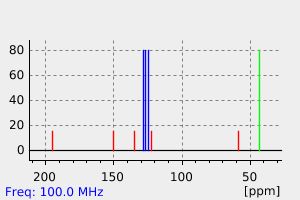2,2,5-tribromoindan-1-one
中文名称
——
中文别名
——
英文名称
2,2,5-tribromoindan-1-one
英文别名
2,2,5-tribromoindanone;2,2,5-tribromo-3H-inden-1-one
CAS
——
化学式
C9H5Br3O
mdl
——
分子量
368.85
InChiKey
PQHWZDFGJBSXJI-UHFFFAOYSA-N
BEILSTEIN
——
EINECS
——
-
物化性质
-
计算性质
-
ADMET
-
安全信息
-
SDS
-
制备方法与用途
-
上下游信息
-
文献信息
-
表征谱图
-
同类化合物
-
相关功能分类
-
相关结构分类
计算性质
-
辛醇/水分配系数(LogP):3.9
-
重原子数:13
-
可旋转键数:0
-
环数:2.0
-
sp3杂化的碳原子比例:0.22
-
拓扑面积:17.1
-
氢给体数:0
-
氢受体数:1
上下游信息
-
上游原料
中文名称 英文名称 CAS号 化学式 分子量 5-溴茚酮 5-Bromo-1-indanone 34598-49-7 C9H7BrO 211.058
反应信息
-
作为反应物:描述:2,2,5-tribromoindan-1-one 反应 0.75h, 以22%的产率得到3,8,13-tribromo-diindeno[1,2-a;1',2'-c]fluorene-5,10,15-trione参考文献:名称:Synthesis, (Non)Linear Optical and Redox Properties of a Donor-Substituted Truxenone Derivative摘要:two-dimensional NLO chromophore (7) with three donor-substituted branches and truxenone as the central coupling unit was synthesised from tribromotruxenone by Stille coupling with N,N-di(4-methoxyphenyl)-4'-(tributylstannylethynyl)phenylamine. UV/visible spectroscopy and hyper-Rayleigh scattering measurements prove the truxenone moiety to be a far stronger electron acceptor than, for example, a nitro group. In addition, coupling of excited states leads to an enhanced quadratic hyperpolarisability of 7 compared with one-dimensional reference chromophores. The large redox-potential separation of about 400 mV of the three reductive waves in the cyclic voltammetry also indicates strong electronic coupling of the truxenone unit. Semiempirical computations at AMI-CI level were used to explain the strong coupling; these calculations also suggest a quartet high-spin state for the truxenone trianion. UV/visible spectroelectrochemical investigations of the oxidation and the first reduction of 7 show that both processes weaken the CT excitation so as to modulate the NLO properties.DOI:10.1002/(sici)1521-3765(19981102)4:11<2129::aid-chem2129>3.0.co;2-0
-
作为产物:参考文献:名称:Synthesis, (Non)Linear Optical and Redox Properties of a Donor-Substituted Truxenone Derivative摘要:two-dimensional NLO chromophore (7) with three donor-substituted branches and truxenone as the central coupling unit was synthesised from tribromotruxenone by Stille coupling with N,N-di(4-methoxyphenyl)-4'-(tributylstannylethynyl)phenylamine. UV/visible spectroscopy and hyper-Rayleigh scattering measurements prove the truxenone moiety to be a far stronger electron acceptor than, for example, a nitro group. In addition, coupling of excited states leads to an enhanced quadratic hyperpolarisability of 7 compared with one-dimensional reference chromophores. The large redox-potential separation of about 400 mV of the three reductive waves in the cyclic voltammetry also indicates strong electronic coupling of the truxenone unit. Semiempirical computations at AMI-CI level were used to explain the strong coupling; these calculations also suggest a quartet high-spin state for the truxenone trianion. UV/visible spectroelectrochemical investigations of the oxidation and the first reduction of 7 show that both processes weaken the CT excitation so as to modulate the NLO properties.DOI:10.1002/(sici)1521-3765(19981102)4:11<2129::aid-chem2129>3.0.co;2-0
文献信息
-
PPh<sub>3</sub>·HBr–DMSO: A Reagent System for Diverse Chemoselective Transformations作者:Kanchan Mal、Amanpreet Kaur、Fazle Haque、Indrajit DasDOI:10.1021/acs.joc.5b00846日期:2015.6.19The broad applicability of the hitherto unexplored reagent combination PPh3 center dot HBr-DMSO is exemplified with multiple highly diverse one-step transformations to synthetically useful building blocks, such as flavones, 4H-thiochromen-4-ones, alpha-hydroxy ketones, 1,4-naphthoquinones (including vitamin K-3), 2-bromo-3-substituted-1H-1-indenones, 2-rnethylthio-1H-1-indenones, 3-butyne-1,2-dione, and 4-pentene-2,3-diones. The simple and mild reaction conditions make the reagent superior in terms of yield and substrate scope in comparison with the existing alternatives.
表征谱图
-
氢谱1HNMR
-
质谱MS
-
碳谱13CNMR
-
红外IR
-
拉曼Raman
-
峰位数据
-
峰位匹配
-
表征信息
同类化合物
(S)-7,7-双[(4S)-(苯基)恶唑-2-基)]-2,2,3,3-四氢-1,1-螺双茚满
(R)-7,7-双[(4S)-(苯基)恶唑-2-基)]-2,2,3,3-四氢-1,1-螺双茚满
(4S,5R)-3,3a,8,8a-四氢茚并[1,2-d]-1,2,3-氧杂噻唑-2,2-二氧化物-3-羧酸叔丁酯
(3aS,8aR)-2-(吡啶-2-基)-8,8a-二氢-3aH-茚并[1,2-d]恶唑
(3aS,3''aS,8aR,8''aR)-2,2''-环戊二烯双[3a,8a-二氢-8H-茚并[1,2-d]恶唑]
(1α,1'R,4β)-4-甲氧基-5''-甲基-6'-[5-(1-丙炔基-1)-3-吡啶基]双螺[环己烷-1,2'-[2H]indene
齐洛那平
鼠完
麝香
风铃醇
颜料黄138
顺式-1,6-二甲基-3-(4-甲基苯基)茚满
雷美替胺杂质9
雷美替胺杂质24
雷美替胺杂质14
雷美替胺杂质13
雷美替胺杂质10
雷美替胺杂质
雷美替胺杂质
雷美替胺杂质
雷美替胺杂质
雷美替胺杂质
雷美替胺
雷沙吉兰相关化合物HCl
雷沙吉兰杂质8
雷沙吉兰杂质5
雷沙吉兰杂质4
雷沙吉兰杂质3
雷沙吉兰杂质16
雷沙吉兰杂质15
雷沙吉兰杂质12
雷沙吉兰杂质1
雷沙吉兰杂质
雷沙吉兰13C3盐酸盐
雷沙吉兰
阿替美唑盐酸盐
铵2-(1,3-二氧代-2,3-二氢-1H-茚-2-基)-8-甲基-6-喹啉磺酸酯
金粉蕨辛
金粉蕨亭
重氮正癸烷
酸性黄3[CI47005]
酒石酸雷沙吉兰
还原茚三酮(二水)
还原茚三酮
过氧化,2,3-二氢-1H-茚-1-基1,1-二甲基乙基
贝沙罗汀杂质8
表蕨素L
螺双茚满
螺[茚-2,4-哌啶]-1(3H)-酮盐酸盐
螺[茚-2,4'-哌啶]-1(3H)-酮







